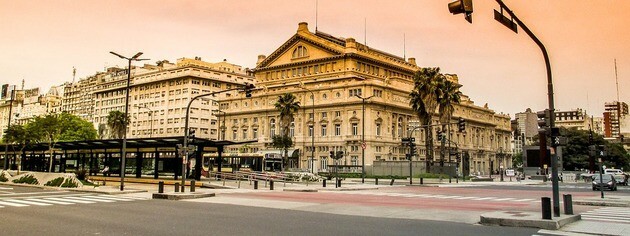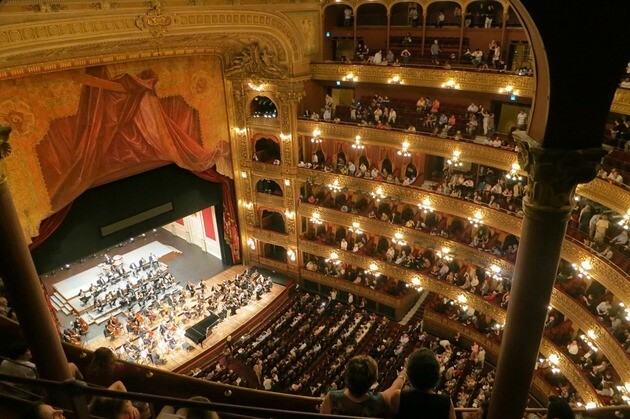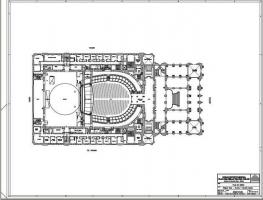Teatro Colón in Buenos Aires: history and characteristics of the building
The Colón Theater in Buenos Aires is considered one of the five best opera houses in the world. This is due to two fundamental elements: its excellent acoustic design and its high architectural level.
This place was originally thought as an exclusive theater for opera, although today symphonic concerts and classical dance are also exhibited.
As an institution, the theater had operated in another headquarters in the Plaza de Mayo since 1857, until it moved to its current headquarters, inaugurated on May 25, 1908, after 20 years of construction.
Let's discover what are the characteristics that make this theater one of the best in the world.
Characteristics of the Teatro Colón
 Represents Argentina's modernizing drive
Represents Argentina's modernizing drive
Before its current headquarters, the Colón Theater was located in the Plaza de Mayo, where it remained between 1857 and 1888.
Towards the end of the 19th century, Argentina was undergoing a fundamental transformation that would determine its historical evolution. In effect, since 1880, the Argentine government sought the modernization of the country through the design of a new agro-export model.
This caused an exponential migratory wave that attracted, above all, Italians and Spaniards, who ended up becoming a very high percentage of the middle class and in a captive market for opera, as this genre was very popular with Europeans, particularly those Italians.
Oriented fundamentally towards opera, the Teatro Colón struggles to catch up with the new times. Thus, they begin the project for their new headquarters, larger and more ambitious, which will represent this modernizing spirit.
Express a universalist will
The social reconfiguration of Argentina made it aspire to the "universal" values of culture as an active part. By the late nineteenth and early twentieth centuries, Western culture had established itself as a universal model, and although America had become almost entirely independent, most of the nations aspired to join that model cultural.
The Teatro Colón seeks to go out and compete in the musical arena with the "greats" of tradition, and with this it intends to become a point of reference for "universal" culture.
Architectural style determined by eclecticism
Architecturally, the Teatro Colón corresponds to the trend of eclecticism typical of the end of the 19th century and early 20th century, in which the architects Francesco Tamburini, Vittorio Meano and Jules Dormal participated.
It is thus a building based on the historical revisionism typical of the architecture of the European modernity, which had not yet managed to consolidate an original style that expressed the times modern.
This type of approach was very well received in Latin America, which was striving to imitate European models in the midst of its rapid growth. Thus, according to Carolina Piola, theater guide, this building becomes a sort of "summary" of European aesthetic history.
For this reason, in this building you can see characteristic features of the Italian Renaissance, as well as German and French architecture.
Building facade

The Colón Theater occupies an area of 63,408 m2. The building's façade is divided into three horizontal stripes: the lower or base, which is 8.50 meters high; the middle one, which is 9.20 meters, and the top one, which is 5.50 meters. Finish off the building with a gabled roof.

Material available at the Landivariana Library - Rafael Landívar University.
As an evocation of the Italian Renaissance you can see columns with Ionic and Corinthian capitals, simple bases and treatment of the openings with arches, moldings and architraves.
Theater interior

Tamburini's initial project follows the structure of the Italian classical theater, for which he conceives the main hall in the shape of a horseshoe, with a 48-meter-high stage. This design allows adequate viewing from anywhere in the theater. In addition, the room has a capacity of approximately 2,500 people seated and 500 standing.
Dormal will be the one who gives the French style to the upper balconies. Also the dimensions of spaces such as lobbies and halls They are based on French models.
Theater dome

The space in the main room is crowned by a dome, the reverse of which is frescoed thanks to the work of the artist Raúl Soldi. Before this painter intervened on the dome, it had been painted by Marcel Jambon, but humidity problems destroyed his work.
On an area of 318 square meters, Soldi represents an allegory to the scenic-musical arts in a composition of 51 figures. Among them you can see theatrical characters, opera singers, musicians, dancers and even instruments.
The figures were painted on canvas and, later, Soldi was in charge of mounting them on the ceiling aided by a scaffolding system.
The dome has a chandelier at its central point, forged in France at the end of the 19th century. This chandelier is made of burnished bronze and has a diameter of seven meters.
Has the best acoustic design in the world for opera

Material available at the Landivariana Library - Rafael Landívar University.
One of the most important aspects of theater is acoustics, which was considered perfect for lyrical singing. The reasons for this phenomenon are derived from the following factors:
- the horseshoe shape of the room that distributes the sound;
- the materials used: the first three levels are loaded with cloth and wood to absorb sound; the top four levels have hard materials, such as marble, to create reverb.
Thus, the Teatro Colón obtains a competitive advantage to become, effectively, a reference center of the opera circuit at an international level.
It houses workshops for show production

The Colón Theater was conceived as a large-scale project that not only guaranteed a good experience to the public in terms of acoustics and visual, but would respond to all the production needs of an operatic show, which, due to its characteristics, is multidisciplinary.
In the basement of the theater there are various workshops for the manufacture of costumes and scenographies, such as such as carpentry, shoe store, props, upholstery, machinery, makeup, hair salon, photography, sculpture, etc.
History of the Teatro Colón
Initially, the design of the Teatro Colón was commissioned to the Italian architect Francesco Tamburini (1846-1891), who since 1884 served as general director of architecture of Argentina.
Although he designed the project, his early death prevented him from starting construction, so architect Vittorio Meano (1860-1904) was hired. However, it also dies a few years before concluding. The work must be adapted and completed by the architect Jules Dormal (1846-1924).
After almost twenty years of construction, begun in 1889, the theater opened its doors on May 24, 1908. The agenda was marked by the representation of the opera Aida, by Giuseppe Verdi.
The theater as an institution houses several stable artistic groupings, the foundation of which dates back to the mid-1920s.
During Peronism, the Teatro Colón opened its programming to popular music. Once Perón's government ended, the theater returned to its original purpose.
Since its opening, this theater has become the scene of important international artists such as Richard Strauss, Igor Stravinsky, Camille Saint-Saëns, Manuel de Falla, Maria Callas, Plácido Domingo and the Argentines Daniel Barenboim and Astor Piazzolla.
Curious facts about the Teatro Colón
- It has a curtain of 700 kilos, which was made in 1936. It has a mouth width of 18.25 meters and a mouth height of 19.25 meters.
- The first two architects died exactly at the age of 44 and before the completion of the work. This was attributed to a curse, so some people wanted to demolish the building.
- It was difficult to find a replacement candidate for the last architect due to superstitious beliefs. Dormal had in his favor the fact that he was over 44 years old when he started.
- Raul Soldi did not charge a fee for painting the dome.
- The theater periodically holds a meeting between the directors and musicians who know the room to evaluate the acoustic level of the space.
- In 2010, the theater received the first international place in acoustics for opera.
- This theater is in the ranking of the best opera houses in the world, sharing fame with the Scala in Milan, the Opera of Paris, the Vienna State Opera, the Royal Opera House in London and the Metropolitan Opera House in New York.
If you want to know in more detail the interior of the Colón Theater, watch the following video:



